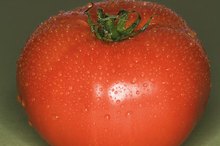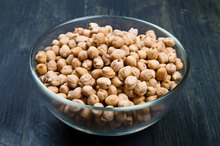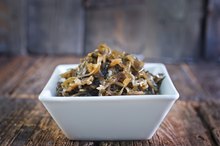What does fact checked mean?
At Healthfully, we strive to deliver objective content that is accurate and up-to-date. Our team periodically reviews articles in order to ensure content quality. The sources cited below consist of evidence from peer-reviewed journals, prominent medical organizations, academic associations, and government data.
The information contained on this site is for informational purposes only, and should not be used as a substitute for the advice of a professional health care provider. Please check with the appropriate physician regarding health questions and concerns. Although we strive to deliver accurate and up-to-date information, no guarantee to that effect is made.
Tamarind Spice Allergy
Tamarind is a spice that is commonly used to make cumin 1. It has its origins in the Far East and is made from a brown bean-pod of the tamarind tree, according to the Epicentre Encyclopedia of Spices 1. Because the spice is made from a legume, you should consult your allergist before using it if you are allergic to other legumes. Legumes include beans, peanuts, lentils and peas. Not everyone who is allergic to a legume will develop an allergic reaction to tamarind 1. Your allergist can perform an allergy test to determine whether or not you have an allergy to this spice.
If you are experiencing serious medical symptoms, seek emergency treatment immediately.
Tamarind Allergy
To be diagnosed with an allergy to tamarind, you will need to undergo certain tests to determine whether or not your body creates immunoglobulin E antibodies when the spice is introduced into your body 1. Immunoglobulin E antibodies are only released when your body experiences an allergic reaction. The presence of these disease-fighting agents is what causes most symptoms to develop because of a chemical chain-reaction that occurs. If your allergist does not observe the presence of immunoglobulin E antibodies, your symptoms are not caused by an allergy but by another condition.
- To be diagnosed with an allergy to tamarind, you will need to undergo certain tests to determine whether or not your body creates immunoglobulin E antibodies when the spice is introduced into your body 1.
- If your allergist does not observe the presence of immunoglobulin E antibodies, your symptoms are not caused by an allergy but by another condition.
The Reaction
What Causes Allergies to Cilantro?
Learn More
You can develop an allergic reaction to any substance you ingest in your body. The immune system reacts to the proteins found in tamarind as if they are going to harm your body 1. This mistake is what causes the immune system to create IgE antibodies to fight against the proteins. IgE antibodies cause:
- mast cells
- located in soft tissues
- to create histamine
- according to the American Academy of Allergy
- Asthma
- Immunology
Histamine is a hormone in the body that helps protect the body from infection, but too much histamine causes swelling. Most allergy symptoms are caused by increased levels of histamine in the body.
- You can develop an allergic reaction to any substance you ingest in your body.
- IgE antibodies cause: * mast cells
* located in soft tissues
* to create histamine
* according to the American Academy of Allergy
* Asthma
* Immunology Histamine is a hormone in the body that helps protect the body from infection, but too much histamine causes swelling.
Symptoms
Symptoms of a food-related allergy may include:
- hives
- eczema
- itching
- tingling in the mouth
- dizziness
- fainting
- lightheadedness
- swelling of the face
- throat
- tongue or lips
- nasal congestion
- trouble breathing
- wheezing
- abdominal pain
- vomiting
- diarrhea
- nausea
- according to MayoClinic.com
Some symptoms may appear within minutes of ingesting tamarind, while others may develop an hour or two after consuming the product 1.
Treatment
Swollen Throat Allergy
Learn More
Once clinically diagnosed with an allergy to tamarind, you will need to avoid the spice 1. It is commonly found in cumin, Asian and Middle Eastern dishes. If you suspect the use of this spice when eating out, ask your server if a dish contains tamarind 1. Consuming even a tiny amount of the substance can cause a severe allergic reaction.
Related Articles
References
- Epicenter.com: Tamarind
- Medline Plus: Allergy Testing
- Tamarinds, raw. FoodData Central. U.S Department of Agriculture. Published April 1, 2019.
- Uchôa Passos T, Alves de Carvalho Sampaio H, Dantas Sabry MO, Pereira de Melo ML, Magalhães Coelho MA, de Oliveira Lima JW. Glycemic index and glycemic load of tropical fruits and the potential risk for chronic diseases. Food Sci Technol (Campinas). 2014;36(1):66-73. doi:10.1590/1678-457X.6449
- Ebifa-Othieno E, Mugisha A, Nyeko P, Kabasa JD. Knowledge, attitudes and practices in tamarind (Tamarindus indica L) use and conservation in Eastern Uganda. J Ethnobiol Ethnomed. 2017;13(1):5. doi:10.1186/s13002-016-0133-8
- Bhadoriya SS, Ganeshpurkar A, Narwaria J, Rai G, Jain AP. Tamarindus indica: Extent of explored potential. Pharmacogn Rev. 2011;5(9):73-81. doi:10.4103/0973-7847.79102
- Lim CY, Mat junit S, Abdulla MA, Abdul Aziz A. In vivo biochemical and gene expression analyses of the antioxidant activities and hypocholesterolaemic properties of Tamarindus indica fruit pulp extract. PLoS ONE. 2013;8(7):e70058. doi:10.1371/journal.pone.0070058
- Sole, SS, Srinivasan BP, Akarte AS. Anti-inflammatory action of Tamarind seeds reduces hyperglycemic excursion by repressing pancreatic β-cell damage and normalizing SREBP-1c concentration. Pharm Biol. 2013 Mar;51(3):350-60. doi:10.3109/13880209.2012.729067
- Komakech R, Kim YG, Matsabisa GM, Kang Y. Anti-inflammatory and analgesic potential of Tamarindus indica Linn. (Fabaceae): A narrative review. Integr Med Res. 2019;8(3):181-186. doi:10.1016/j.imr.2019.07.002
- Hivrale MG, Bandawane DD, Mali AA. Anti-inflammatory and analgesic activities of petroleum ether and ethyl acetate fractions of Tamarindus indica seeds. Orient Pharm Exp Med. 2013;13:319–326. doi:10.1007/s13596-013-0116-4
- US Food and Drug Administration. Food Allergen Labeling and Consumer Protection Act of 2004 questions and answers. Updated July 16, 2018.
- Centers for Disease Control and Prevention. Lead in foods, cosmetics, and medicine. Updated July 30, 2019.
Writer Bio
Diane Marks started her writing career in 2010 and has been in health care administration for more than 30 years. She holds a registered nurse license from Citizens General Hospital School of Nursing, a Bachelor of Arts in health care education from California University of Pennsylvania and a Master of Science in health administration from the University of Pittsburgh.









